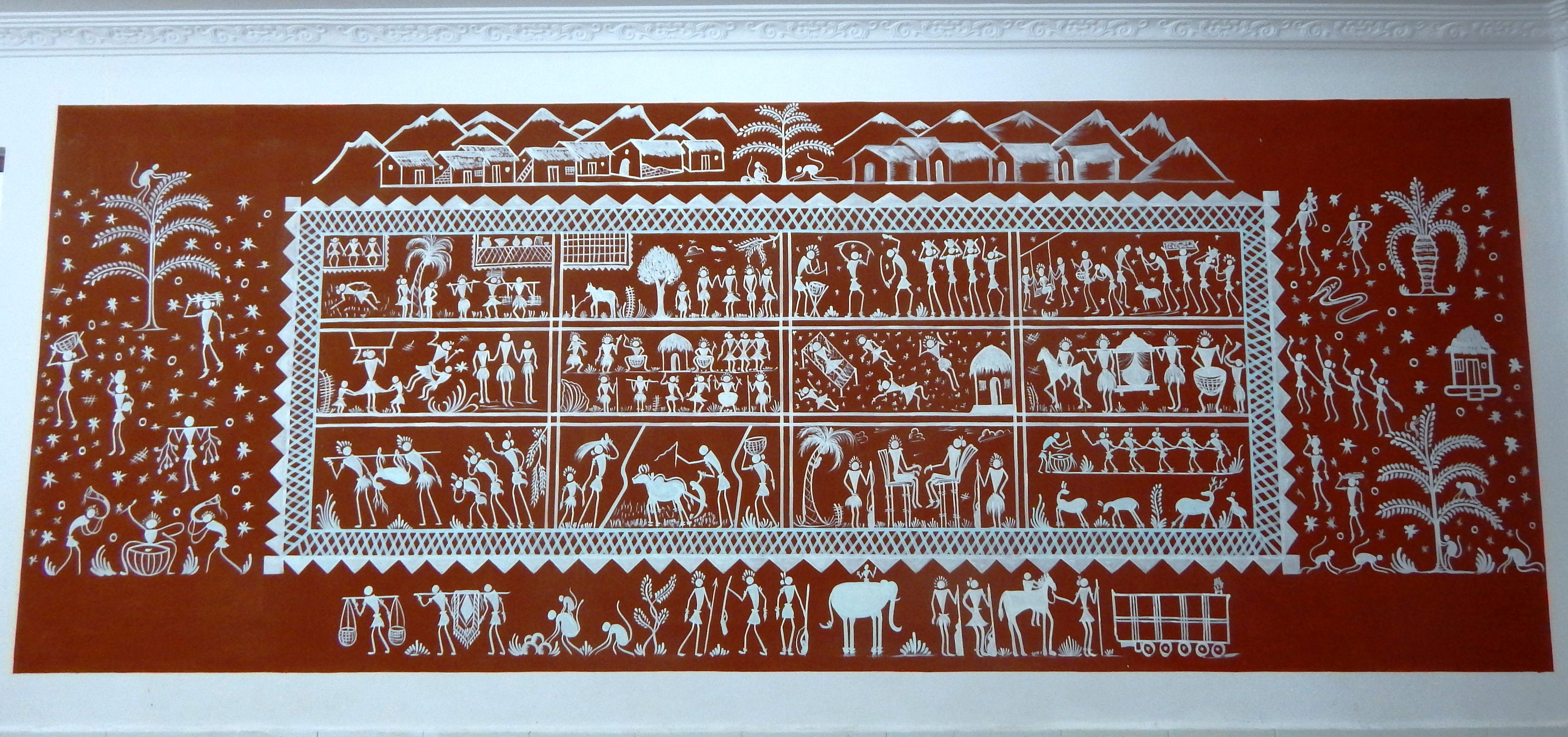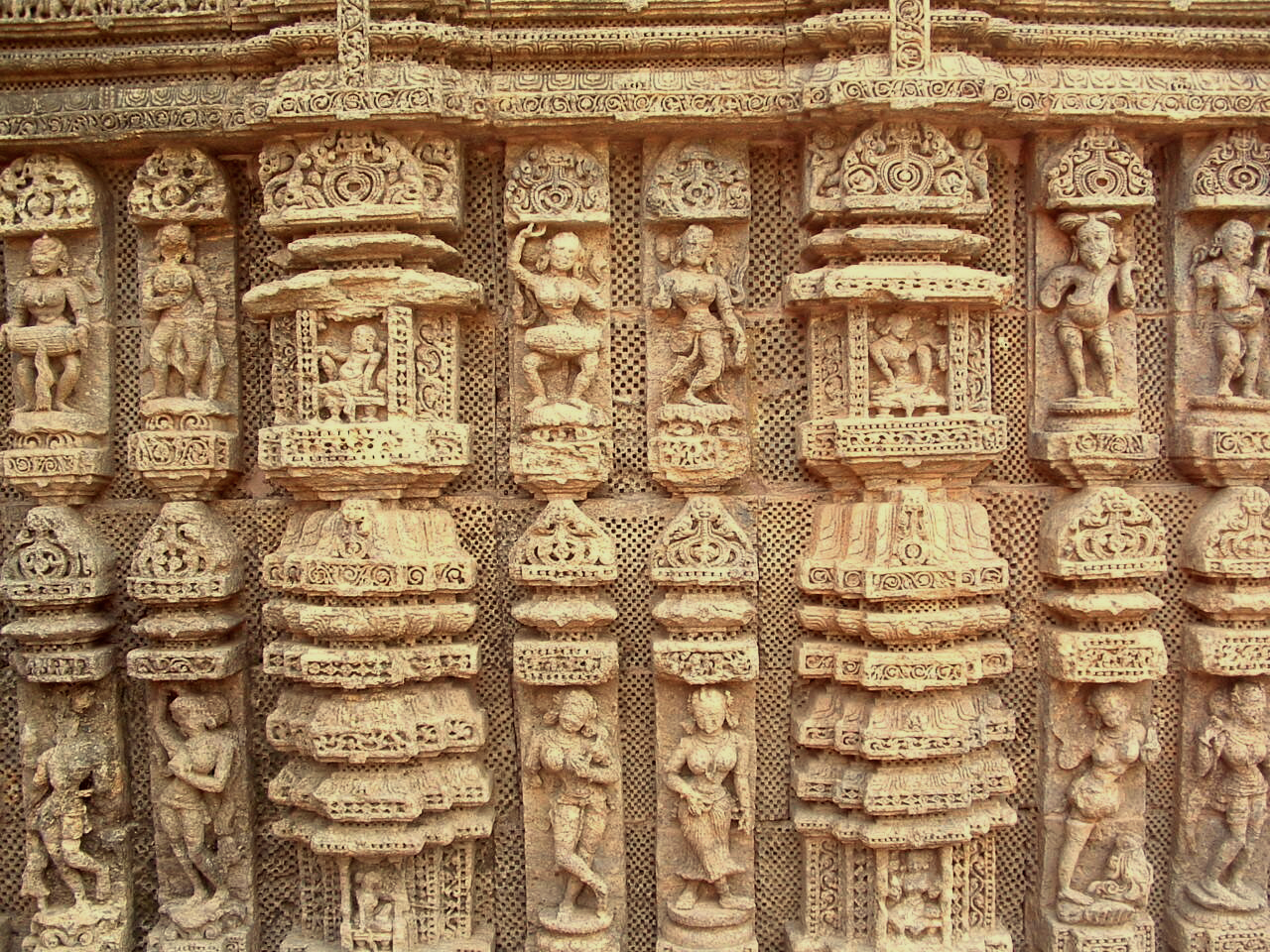|
Idital
Idital or Edital is a form of Indian painting from the state of Odisha. It is a kind of Saura painting that was invented and is practiced by the Sora people who mostly live in Rayagada, Gajapati and Koraput districts of Odisha. The artisans paint Idital as a symbol of devotion to the tribal deity "Idital" or "Edital". Each piece of Idital painting contains symbols and signs and each one of them convey a distinct meaning. "''Jodisum''" and "''Jananglasum''" are two known Idital styles. Origin and History Seven out of the 62 tribes of Odisha decorate their wall with mural paintings. Sora are known for their wide range of painting styles based on religious and ceremonial themes. They have invariably religious association for which they are called ''italon'' or ''ikon''. ''Ikon''s used to be originally painted on the walls of the adobe huts of the Sora people. ''Ikon''s are worshipped during special religious and cultural occasions such as child-birth, harvest, marriage and the constr ... [...More Info...] [...Related Items...] OR: [Wikipedia] [Google] [Baidu] |
Saura Painting
Saura painting is a style of wall mural paintings associated with the Saura tribals of the state of Odisha in India. These paintings, also called ''ikons'' (or ''ekons'') are visually similar to Warli paintings and hold religious significance for the Sauras. The Saura tribe Sauras are among the most ancient of tribes in India and find mention in the Hindu epics of Ramayana and Mahabharata. Savari, Rama's devotee in the Ramayana and Jara, the hunter who mortally wounded Krishna with an arrow, are thought to have been members of this tribe. Lord Krishna's body is believed to have flowed into the sea near Puri as a wooden log and the idol Jagannath at Puri is believed to have been sculpted from it. Saura paintings are an integral part of the religious ceremonies of the Saura tribals and are found in the southern Odisha districts of Rayagada, Ganjam, Gajapati and Koraput. Saura paintings were first studied by the famous anthropologist Verrier Elwin. Paintings The Saura ... [...More Info...] [...Related Items...] OR: [Wikipedia] [Google] [Baidu] |
Tree Of Life
The tree of life is a fundamental archetype in many of the world's mythological, religious, and philosophical traditions. It is closely related to the concept of the sacred tree.Giovino, Mariana (2007). ''The Assyrian Sacred Tree: A History of Interpretations'', page 129. Saint-Paul. The concept of the tree of life may have originated in Central Asia, and absorbed by other cultures, such as Scandinavian mythology and Altai shamanism. The tree of knowledge, connecting to heaven and the underworld, and the tree of life, connecting all forms of creation, are both forms of the world tree or cosmic tree, and are portrayed in various religions and philosophies as the same tree. Religion and mythology Various trees of life are recounted in folklore, culture and fiction, often relating to immortality or fertility. They had their origin in religious symbolism. According to professor Elvyra Usačiovaitė, a "typical" imagery preserved in ancient iconography is that of two s ... [...More Info...] [...Related Items...] OR: [Wikipedia] [Google] [Baidu] |
Arts Of Odisha
The Indian state of Odisha has a rich cultural and artistic heritage. Due to the reign of many different rulers in the past, arts and crafts in Odisha underwent many changes giving an artistic diversity today in the forms of traditional handicrafts, painting and carving, dance and music, clothing, etc. Dance and music Odisha Others Aside from the Odissi dance there are many other forms of dance and folk performances in Odisha. These include Baunsa Rani, Chaiti Ghoda, Changu Nata, Chhau, Dalkhai, Danda Nata, Pala, Dasakathia, Dhanu Jatra, Ghanta Patua, Ghumura, Karma Naach, Kathinacha, Kedu, Kela Keluni, Laudi Khela, Gopalila Medha Nacha, Naga Dance, Paika Nrutya, Jatra, Patua Jatra, Puppet Dance, Ranappa and Samprada. Music The 16th century witnessed the compilation of literature within music. The four important treatises written during that time are Sangitamava Chandrika, Natya Manorama, Sangita Kalalata and Gita Prakasha. Orissi music is a ... [...More Info...] [...Related Items...] OR: [Wikipedia] [Google] [Baidu] |
Tamarind
Tamarind (''Tamarindus indica'') is a leguminous tree bearing edible fruit that is probably indigenous to tropical Africa. The genus ''Tamarindus'' is monotypic, meaning that it contains only this species. It belongs to the family Fabaceae. The tamarind tree produces brown, pod-like fruits that contain a sweet, tangy pulp, which is used in cuisines around the world. The pulp is also used in traditional medicine and as a metal polish. The tree's wood can be used for woodworking and tamarind seed oil can be extracted from the seeds. Tamarind's tender young leaves are used in Indian and Filipino cuisine. Because tamarind has multiple uses, it is cultivated around the world in tropical and subtropical zones. Description The tamarind is a long-lived, medium-growth tree, which attains a maximum crown height of . The crown has an irregular, vase-shaped outline of dense foliage. The tree grows well in full sun. It prefers clay, loam, sandy, and acidic soil types, with a h ... [...More Info...] [...Related Items...] OR: [Wikipedia] [Google] [Baidu] |
Vermilion
Vermilion (sometimes vermillion) is a color, color family, and pigment most often made, since antiquity until the 19th century, from the powdered mineral cinnabar (a form of mercury sulfide, which is toxic) and its corresponding color. It is very often synonymous with red orange, which often takes a modern form just 11% brighter (at full brightness). Etymology and orthography The word vermilion came from the Old French word ''vermeillon'', which was derived from ''vermeil'', from the Latin ''vermiculus'', the diminutive of the Latin word ''vermis'', or worm. The name originated because it had a similar color to the natural red dye made from an insect, '' Kermes vermilio'', which was widely used in Europe. The first recorded use of "vermilion" as a color name in English was in 1289. The term cinnabar was used interchangeably with vermilion until the 17th century, when vermilion became the more common name. Now the term "cinnabar" is used in mineralogy and crystallography ... [...More Info...] [...Related Items...] OR: [Wikipedia] [Google] [Baidu] |
Bamboo Shoots
Bamboo shoots or bamboo sprouts are the edible shoots (new bamboo culms that come out of the ground) of many bamboo species including ''Bambusa vulgaris'' and ''Phyllostachys edulis''. They are used as vegetables in numerous Asian dishes and broths. They are sold in various processed shapes, and are available in fresh, dried, and canned versions. Raw bamboo shoots contain cyanogenic glycosides, natural toxins also contained in cassava. The toxins must be destroyed by thorough cooking and for this reason fresh bamboo shoots are boiled before being used in other ways. The toxins are also destroyed in the canning process. Harvested species Most young shoots of bamboo are edible after being boiled to remove toxins, but only around a hundred or so species are harvested regularly for edible shoots. These are usually from species that are also cultivated for other uses. These include: *''Acidosasa'' – native to South China and Vietnam :*''Acidosasa edulis'' – endemic to the prov ... [...More Info...] [...Related Items...] OR: [Wikipedia] [Google] [Baidu] |
Yellow Ochre
Ochre ( ; , ), or ocher in American English, is a natural clay earth pigment, a mixture of ferric oxide and varying amounts of clay and sand. It ranges in colour from yellow to deep orange or brown. It is also the name of the colours produced by this pigment, especially a light brownish-yellow. A variant of ochre containing a large amount of hematite, or dehydrated iron oxide, has a reddish tint known as "red ochre" (or, in some dialects, ruddle). The word ochre also describes clays coloured with iron oxide derived during the extraction of tin and copper. Earth pigments Ochre is a family of earth pigments, which includes yellow ochre, red ochre, purple ochre, sienna, and umber. The major ingredient of all the ochres is iron(III) oxide-hydroxide, known as limonite, which gives them a yellow colour. * Yellow ochre, , is a hydrated iron hydroxide (limonite) also called gold ochre. * Red ochre, , takes its reddish colour from the mineral hematite, which is an anhydrous iron o ... [...More Info...] [...Related Items...] OR: [Wikipedia] [Google] [Baidu] |
Motif (visual Arts)
In art and iconography, a motif () is an element of an image. The term can be used both of figurative and narrative art, and ornament and geometrical art. A motif may be repeated in a pattern or design, often many times, or may just occur once in a work. A motif may be an element in the iconography of a particular subject or type of subject that is seen in other works, or may form the main subject, as the Master of Animals motif in ancient art typically does. The related motif of confronted animals is often seen alone, but may also be repeated, for example in Byzantine silk and other ancient textiles. Where the main subject of an artistic work such as a painting is a specific person, group, or moment in a narrative, that should be referred to as the "subject" of the work, not a motif, though the same thing may be a "motif" when part of another subject, or part of a work of decorative art such as a painting on a vase. Ornamental or decorative art can usually be analysed in ... [...More Info...] [...Related Items...] OR: [Wikipedia] [Google] [Baidu] |
Moon
The Moon is Earth's only natural satellite. It is the fifth largest satellite in the Solar System and the largest and most massive relative to its parent planet, with a diameter about one-quarter that of Earth (comparable to the width of Australia). The Moon is a planetary-mass object with a differentiated rocky body, making it a satellite planet under the geophysical definitions of the term and larger than all known dwarf planets of the Solar System. It lacks any significant atmosphere, hydrosphere, or magnetic field. Its surface gravity is about one-sixth of Earth's at , with Jupiter's moon Io being the only satellite in the Solar System known to have a higher surface gravity and density. The Moon orbits Earth at an average distance of , or about 30 times Earth's diameter. Its gravitational influence is the main driver of Earth's tides and very slowly lengthens Earth's day. The Moon's orbit around Earth has a sidereal period of 27.3 days. During each s ... [...More Info...] [...Related Items...] OR: [Wikipedia] [Google] [Baidu] |
Odisha
Odisha (English: , ), formerly Orissa ( the official name until 2011), is an Indian state located in Eastern India. It is the 8th largest state by area, and the 11th largest by population. The state has the third largest population of Scheduled Tribes in India. It neighbours the states of Jharkhand and West Bengal to the north, Chhattisgarh to the west, and Andhra Pradesh to the south. Odisha has a coastline of along the Bay of Bengal in Indian Ocean. The region is also known as Utkala and is also mentioned in India's national anthem, " Jana Gana Mana". The language of Odisha is Odia, which is one of the Classical Languages of India. The ancient kingdom of Kalinga, which was invaded by the Mauryan Emperor Ashoka (which was again won back from them by King Kharavela) in 261 BCE resulting in the Kalinga War, coincides with the borders of modern-day Odisha. The modern boundaries of Odisha were demarcated by the British Indian government when Orissa Province was es ... [...More Info...] [...Related Items...] OR: [Wikipedia] [Google] [Baidu] |
Elephants
Elephants are the largest existing land animals. Three living species are currently recognised: the African bush elephant, the African forest elephant, and the Asian elephant. They are the only surviving members of the family Elephantidae and the order Proboscidea. The order was formerly much more diverse during the Pleistocene, but most species became extinct during the Late Pleistocene epoch. Distinctive features of elephants include a long proboscis called a trunk, tusks, large ear flaps, pillar-like legs, and tough but sensitive skin. The trunk is used for breathing, bringing food and water to the mouth, and grasping objects. Tusks, which are derived from the incisor teeth, serve both as weapons and as tools for moving objects and digging. The large ear flaps assist in maintaining a constant body temperature as well as in communication. African elephants have larger ears and concave backs, whereas Asian elephants have smaller ears, and convex or level backs. Elephant ... [...More Info...] [...Related Items...] OR: [Wikipedia] [Google] [Baidu] |






_colourised.png)